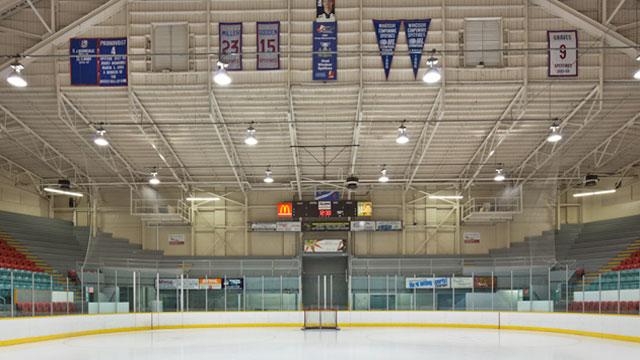By Shannon Proudfoot, Sportsnet Magazine
Photography by Eugen Sakhnenko
There are few places in hockey where the seventh man got as good a run at the on-ice action as in Ontario’s Windsor Arena. The blue-collar crowd, perched on seats that practically hung over the glass above the ice, tormented the other team’s goaltender and heckled players on their way to the bench or penalty box, filling the old building to the rafters with loud love for the home team and hatred for the enemy. If arenas were players, Windsor’s old barn would be a world-class pest: beloved by the home team and its fans, loathed by everyone else.
“It wasn’t a fun building for other teams to come play in,” recalls Boston coach Claude Julien, who played two seasons here with the Ontario Hockey League’s Windsor Spitfires starting in 1978. “We were a pretty physical team at the time and the crowd was right on top of you, so it was an intimidating rink.” But now, the stands are quiet, the ice has melted away and another one of Canada’s hockey temples is on the verge of extinction.
When it opened in 1924, it was christened the Border Cities Arena; it was later renamed Windsor Arena, but to those who love it, it’s simply “The Barn.” From the outside, the stout yellow walls and peaked brown roof wouldn’t look out of place in a grassy field surrounded by dozing cows. But inside, a white-painted ceiling and girders loom dramatically above the ice. If you were lucky enough to get a seat in the first row, your knees would be mashed up against the boards; a few rows farther up and you’d have an almost bird’s-eye view of the action, and a privileged spot from which to yell at the players and referees. “There was nothing else like it,” says Randy Cloutier. He started playing minor hockey in The Barn when he was five and working there when he was 15. He spent 30 years there, working his way up to head rink attendant and looking after everything that made the place run. “It’s like home for me,” he says.
brightcove.createExperiences();
One end of the ice featured a sort of catwalk where fans could stand with just a fence separating them from the other team’s netminder for two periods every night. Patrons loved it; visiting goalies not so much. Until the late ’80s, the “Madhouse on McDougal” had nothing more than a hapless official between opposing players in the sin bin. “I remember having to get into a scuffle in the penalty box with the other player because there was nothing separating us,” Julien says. Players had to cross the concourse to get to the dressing rooms, providing another opportunity for audience participation, and once they got there, they had to keep their shoes and clothes off the floor and away from the literal rink rats, who had the run of the place.
The Barn was updated and expanded over the years, but the ice surface was always a little smaller than standard, breeding a fast, in-your-face brand of hockey that was classic Windsor. The rink had its brushes with greatness, too. The Detroit Cougars spent their first season here in 1926 while waiting for the Olympia to be built across the river; a few years later they became the Red Wings. Wayne Gretzky played here in the 1978 OHL all-star game, and Grant Fuhr, Doug Gilmour and Dale Hawerchuk battled for the 1981 Memorial Cup on this ice. Don Cherry began his junior hockey career here, in 1951–52. “That was hockey,” Grapes remembers. “The people could reach out and touch you, almost, and the ice was always dynamite. The smell was great, too.”
But now, The Barn and the memories that live in its walls are about to fade away. The WFCU Centre opened across town in 2008, boasting a 6,500-seat spectator arena, three other ice pads, a community centre and a seniors centre. It doesn’t have much soul, but it’s beautiful and state-of-the-art, and the city decided it was too inefficient to keep The Barn going. They held the last skate in March of this year and then removed the ice. A developer is hoping to hack out the walls and punch skylights in the roof to turn The Barn into a slick “urban mall.” The home of hard-nosed hockey will be gentrified beyond recognition.
The Spitfires played their last game here in December 2008, and when the team moved to the WFCU Centre, Cloutier went with them. They held a farewell ceremony after the last game, lowering the dusty banners and retired numbers from the rafters. Long after the Spitfires’ players and coaches waved goodbye to the building and fans and drove off, Cloutier stayed down on the ice, posing with kids who wanted a photo with “the Zamboni guy.” Once all the fans left, he went about his usual post-game business, resurfacing the ice and cleaning up. Around midnight, he took one last slow look around, then turned off the lights, locked the door and left. He likes working in the new arena well enough, but it’s just not the same.
“There’s a lot more going on, but you still don’t have that feeling of Windsor Arena,” he says. “I’ll always have that in my blood.”
